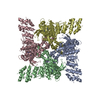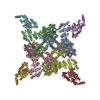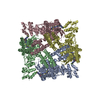+ Open data
Open data
- Basic information
Basic information
| Entry | Database: PDB / ID: 8jvi | |||||||||||||||||||||||||||||||||||||||||||||
|---|---|---|---|---|---|---|---|---|---|---|---|---|---|---|---|---|---|---|---|---|---|---|---|---|---|---|---|---|---|---|---|---|---|---|---|---|---|---|---|---|---|---|---|---|---|---|
| Title | Structure of human TRPV4 with antagonist A2 | |||||||||||||||||||||||||||||||||||||||||||||
 Components Components | Transient receptor potential cation channel subfamily V member 4,3C-GFP | |||||||||||||||||||||||||||||||||||||||||||||
 Keywords Keywords | MEMBRANE PROTEIN / Channel | |||||||||||||||||||||||||||||||||||||||||||||
| Function / homology |  Function and homology information Function and homology informationstretch-activated, monoatomic cation-selective, calcium channel activity / blood vessel endothelial cell delamination / regulation of response to osmotic stress / osmosensor activity / vasopressin secretion / calcium ion import into cytosol / negative regulation of brown fat cell differentiation / positive regulation of microtubule depolymerization / positive regulation of striated muscle contraction / positive regulation of macrophage inflammatory protein 1 alpha production ...stretch-activated, monoatomic cation-selective, calcium channel activity / blood vessel endothelial cell delamination / regulation of response to osmotic stress / osmosensor activity / vasopressin secretion / calcium ion import into cytosol / negative regulation of brown fat cell differentiation / positive regulation of microtubule depolymerization / positive regulation of striated muscle contraction / positive regulation of macrophage inflammatory protein 1 alpha production / hyperosmotic salinity response / positive regulation of chemokine (C-X-C motif) ligand 1 production / positive regulation of chemokine (C-C motif) ligand 5 production / cartilage development involved in endochondral bone morphogenesis / cellular hypotonic salinity response / cellular hypotonic response / cortical microtubule organization / multicellular organismal-level water homeostasis / positive regulation of vascular permeability / osmosensory signaling pathway / cell-cell junction assembly / positive regulation of monocyte chemotactic protein-1 production / calcium ion import / cell volume homeostasis / cellular response to osmotic stress / regulation of aerobic respiration / TRP channels / cortical actin cytoskeleton / diet induced thermogenesis / positive regulation of macrophage chemotaxis / microtubule polymerization / calcium ion import across plasma membrane / response to mechanical stimulus / alpha-tubulin binding / beta-tubulin binding / monoatomic cation channel activity / cytoplasmic microtubule / SH2 domain binding / protein kinase C binding / actin filament organization / positive regulation of JNK cascade / adherens junction / filopodium / response to insulin / calcium ion transmembrane transport / positive regulation of interleukin-6 production / calcium channel activity / ruffle membrane / intracellular calcium ion homeostasis / positive regulation of inflammatory response / actin filament binding / calcium ion transport / glucose homeostasis / lamellipodium / negative regulation of neuron projection development / cellular response to heat / positive regulation of cytosolic calcium ion concentration / growth cone / actin binding / actin cytoskeleton organization / High laminar flow shear stress activates signaling by PIEZO1 and PECAM1:CDH5:KDR in endothelial cells / microtubule binding / calmodulin binding / response to hypoxia / positive regulation of ERK1 and ERK2 cascade / cilium / apical plasma membrane / focal adhesion / lipid binding / protein kinase binding / cell surface / endoplasmic reticulum / negative regulation of transcription by RNA polymerase II / ATP binding / metal ion binding / identical protein binding / membrane / plasma membrane Similarity search - Function | |||||||||||||||||||||||||||||||||||||||||||||
| Biological species |  Homo sapiens (human) Homo sapiens (human)synthetic construct (others) | |||||||||||||||||||||||||||||||||||||||||||||
| Method | ELECTRON MICROSCOPY / single particle reconstruction / cryo EM / Resolution: 3.21 Å | |||||||||||||||||||||||||||||||||||||||||||||
 Authors Authors | Fan, J. / Lei, X. | |||||||||||||||||||||||||||||||||||||||||||||
| Funding support |  China, 1items China, 1items
| |||||||||||||||||||||||||||||||||||||||||||||
 Citation Citation |  Journal: Adv Sci (Weinh) / Year: 2024 Journal: Adv Sci (Weinh) / Year: 2024Title: Structural Pharmacology of TRPV4 Antagonists. Authors: Junping Fan / Chang Guo / Daohong Liao / Han Ke / Jing Lei / Wenjun Xie / Yuliang Tang / Makoto Tominaga / Zhuo Huang / Xiaoguang Lei /   Abstract: The nonselective calcium-permeable Transient Receptor Potential Cation Channel Subfamily V Member4 (TRPV4) channel regulates various physiological activities. Dysfunction of TRPV4 is linked to many ...The nonselective calcium-permeable Transient Receptor Potential Cation Channel Subfamily V Member4 (TRPV4) channel regulates various physiological activities. Dysfunction of TRPV4 is linked to many severe diseases, including edema, pain, gastrointestinal disorders, lung diseases, and inherited neurodegeneration. Emerging TRPV4 antagonists show potential clinical benefits. However, the molecular mechanisms of TRPV4 antagonism remain poorly understood. Here, cryo-electron microscopy (cryo-EM) structures of human TRPV4 are presented in-complex with two potent antagonists, revealing the detailed binding pockets and regulatory mechanisms of TRPV4 gating. Both antagonists bind to the voltage-sensing-like domain (VSLD) and stabilize the channel in closed states. These two antagonists induce TRPV4 to undergo an apparent fourfold to twofold symmetry transition. Moreover, it is demonstrated that one of the antagonists binds to the VSLD extended pocket, which differs from the canonical VSLD pocket. Complemented with functional and molecular dynamics simulation results, this study provides crucial mechanistic insights into TRPV4 regulation by small-molecule antagonists, which may facilitate future drug discovery targeting TRPV4. | |||||||||||||||||||||||||||||||||||||||||||||
| History |
|
- Structure visualization
Structure visualization
| Structure viewer | Molecule:  Molmil Molmil Jmol/JSmol Jmol/JSmol |
|---|
- Downloads & links
Downloads & links
- Download
Download
| PDBx/mmCIF format |  8jvi.cif.gz 8jvi.cif.gz | 463 KB | Display |  PDBx/mmCIF format PDBx/mmCIF format |
|---|---|---|---|---|
| PDB format |  pdb8jvi.ent.gz pdb8jvi.ent.gz | 358.9 KB | Display |  PDB format PDB format |
| PDBx/mmJSON format |  8jvi.json.gz 8jvi.json.gz | Tree view |  PDBx/mmJSON format PDBx/mmJSON format | |
| Others |  Other downloads Other downloads |
-Validation report
| Arichive directory |  https://data.pdbj.org/pub/pdb/validation_reports/jv/8jvi https://data.pdbj.org/pub/pdb/validation_reports/jv/8jvi ftp://data.pdbj.org/pub/pdb/validation_reports/jv/8jvi ftp://data.pdbj.org/pub/pdb/validation_reports/jv/8jvi | HTTPS FTP |
|---|
-Related structure data
| Related structure data |  36675MC  8ju5C  8ju6C  8jvjC M: map data used to model this data C: citing same article ( |
|---|---|
| Similar structure data | Similarity search - Function & homology  F&H Search F&H Search |
- Links
Links
- Assembly
Assembly
| Deposited unit | 
|
|---|---|
| 1 |
|
- Components
Components
| #1: Protein | Mass: 128628.547 Da / Num. of mol.: 4 Source method: isolated from a genetically manipulated source Details: Author stated: The section (872-874) is the cloning site. The domain (875-882) is PreScission Site. The domain (883-1116) is corresponding to this sfGFP (462-695 amino acids, GenBank: ...Details: Author stated: The section (872-874) is the cloning site. The domain (875-882) is PreScission Site. The domain (883-1116) is corresponding to this sfGFP (462-695 amino acids, GenBank: ALP48449.1). The domain (1117-1144) is the expression Tag. Source: (gene. exp.)  Homo sapiens (human), (gene. exp.) synthetic construct (others) Homo sapiens (human), (gene. exp.) synthetic construct (others)Gene: TRPV4, VRL2, VROAC / Production host:  Homo sapiens (human) / References: UniProt: Q9HBA0 Homo sapiens (human) / References: UniProt: Q9HBA0#2: Chemical | ChemComp-F9M / [ Mass: 572.628 Da / Num. of mol.: 4 / Source method: obtained synthetically / Formula: C25H23F3N8OS2 / Feature type: SUBJECT OF INVESTIGATION Has ligand of interest | Y | Has protein modification | N | |
|---|
-Experimental details
-Experiment
| Experiment | Method: ELECTRON MICROSCOPY |
|---|---|
| EM experiment | Aggregation state: PARTICLE / 3D reconstruction method: single particle reconstruction |
- Sample preparation
Sample preparation
| Component | Name: TRPV4 / Type: COMPLEX / Entity ID: #1 / Source: RECOMBINANT |
|---|---|
| Molecular weight | Value: 0.4 MDa / Experimental value: NO |
| Source (natural) | Organism:  Homo sapiens (human) Homo sapiens (human) |
| Source (recombinant) | Organism:  Homo sapiens (human) Homo sapiens (human) |
| Buffer solution | pH: 8 |
| Specimen | Embedding applied: NO / Shadowing applied: NO / Staining applied: NO / Vitrification applied: YES |
| Vitrification | Cryogen name: ETHANE |
- Electron microscopy imaging
Electron microscopy imaging
| Experimental equipment |  Model: Titan Krios / Image courtesy: FEI Company |
|---|---|
| Microscopy | Model: FEI TITAN KRIOS |
| Electron gun | Electron source:  FIELD EMISSION GUN / Accelerating voltage: 300 kV / Illumination mode: FLOOD BEAM FIELD EMISSION GUN / Accelerating voltage: 300 kV / Illumination mode: FLOOD BEAM |
| Electron lens | Mode: BRIGHT FIELD / Nominal defocus max: 2000 nm / Nominal defocus min: 1000 nm |
| Image recording | Electron dose: 60 e/Å2 / Film or detector model: GATAN K2 SUMMIT (4k x 4k) |
- Processing
Processing
| EM software | Name: PHENIX / Category: model refinement | ||||||||||||||||||||||||
|---|---|---|---|---|---|---|---|---|---|---|---|---|---|---|---|---|---|---|---|---|---|---|---|---|---|
| CTF correction | Type: PHASE FLIPPING AND AMPLITUDE CORRECTION | ||||||||||||||||||||||||
| 3D reconstruction | Resolution: 3.21 Å / Resolution method: FSC 0.143 CUT-OFF / Num. of particles: 48492 / Symmetry type: POINT | ||||||||||||||||||||||||
| Refine LS restraints |
|
 Movie
Movie Controller
Controller






 PDBj
PDBj

